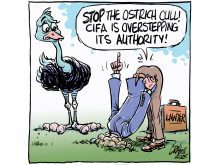Neil Wagstaff was sitting on his Elnora, Alta., farm southeast of Red Deer April 28 looking at snowdrifts a metre high and wondering about the impact on spring seeding.
“It’s hard to fathom this much snow and this much moisture at this time of year,” he said after a record spring blizzard closed down large parts of southern and central Alberta on the weekend.
“I think we might have a problem getting our seeding done on time.”
But the president of Wild Rose Agriculture Producers also quickly acknowledged the upside of the storm. There is moisture and with it, dreams of better growing conditions this year.
Read Also

Budget seen as fairly solid, but worrying cracks appear
The reaction from the agriculture industry to prime minister Mark Carney’s first budget handed down November 4th has been largely positive.
In many parts of the Prairies, soggy ground is bringing smiles.
“We had some rain on the weekend and there’s nothing like a spring rain to lift farmers’ spirits,” Manitoba Canadian Alliance MP and cattle producer Howard Hilstrom reported April 28 when he returned to Parliament Hill from two weeks in the riding.
In Saskatchewan, farm leader Terry Hildebrandt also reported better rains this year than he has seen in several springs.
“The dugouts are full and there’s moisture except in that area west from Battleford,” he said. “It depends on what the weather does from now, but there is some reason to hope for a better growing year.”
Hal Cushon, Saskatchewan’s assistant deputy agriculture minister, has been seeing and feeling the effects on farmers.
“It’s interesting to see the level of optimism out there, higher than I’ve seen it for some years,” he said. Despite dire predictions about a livestock selloff because of a lack of feed after last year’s drought, Saskatchewan cattle numbers are up this year and a government survey suggested there are few concerns about feed availability.
“I’m just seeing a better mood around.”
Of course, no picture of the farm community would be complete without sketching in a few dark clouds and there are plenty of those around.
Agriculture Canada last week projected a sharp drop in net farm income in 2003 despite record or near-record program payments. In Saskatchewan, realized net income is projected to be one-third of 2001 levels while Alberta’s realized net income is projected to fall 61 percent from last year’s high. Market receipts will drop and operating expenses will increase at or near double-digit levels.
Meanwhile, governments seem hell-bent on introducing new farm safety net programs despite widespread farmer concerns that they will not be adequate.
Farm leaders say they are hearing producers express frustration and anger over what they see as governments ignoring their concerns over safety net design.
Still, out where the moisture meets the soil, farm politics are not the main concern. The promise, the mere hint of a bountiful or even normal crop year puts a spring in some steps.
“You know farmers are perpetual optimists,” said Wagstaff. “Of course, a good crop could mean oversupply and lower prices, but that’s what drives us.”
Farm lobbyists appearing on Parliament Hill insist that asking for government help is a last resort. This year’s reports of sporadic outbreaks of optimism reaffirm the point.














